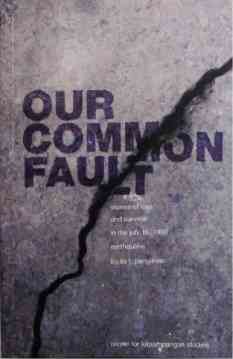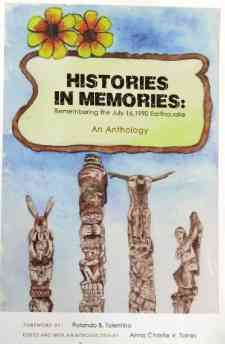The government’s chief volcanologist, Dr. Renato Solidum, isn’t one to dismiss the stories of survivors, especially in a country where earthquakes and typhoons happen regularly and, at times, in disastrous proportions.
“The narratives of survivors are important so that readers are made aware of how hazards are felt, how they can be affected, how they survived and coped with the disasters,” said Solidum, head of the Philippine Institute of Volcanology and Seismology (Phivolcs).
The book, “Our Common Fault,” complements the numerous scientific reports on the 7.8-magnitude earthquake that shook mainland Luzon on July 16, 1990.
It has been 26 years and Phivolcs still carries on its website (phivolcs.dost.gov.ph) the technical monograph made by an interagency committee that documented and established the database of that major incident.
Lia Pangilinan, a language and literature graduate and researcher, collated the stories and, in the process, got to know the destructive side of nature and the ordeal of the victims.
“I felt the trauma and suffering brought by this disaster through the stories I gathered from my interviewees. Now I understand, or I have begun to understand how the 1990 Luzon earthquake affected us all,” Pangilinan said, repeating her foreword during the launch of the book on the eve of the 25th anniversary of the June 15, 1991, eruption of Mt. Pinatubo.
The late Phivolcs chief, Dr. Raymundo Punongbayan, had said the 1990 quake disturbed the geological setting of the volcano, hastening the eruption, which became the world’s second largest in the 20th century after Mt. Novarupta in Alaska.
Published by Holy Angel University’s Center for Kapampangan Studies, “Our Common Fault” presents 79 narratives by 77 survivors and responders in the provinces of Nueva Ecija, Tarlac, Pampanga and Bulacan in Central Luzon, La Union and Pangasinan in Ilocos region, Benguet and Baguio City in Cordillera, Nueva Vizcaya in Cagayan Valley, and Metro Manila.
Witnesses—even in journalism, courts and the church—bring honesty to experiences, Pangilinan said.
She wrote: “These stories are but a small portion of the collective voices of the survivors of the quake. These are their stories, which unraveled and wrote themselves, both of survival and loss. May this book help you further understand what they went through and why they all chose to stand back up on their feet and begin again.”
Ominous signs
The accounts referred to ominous signs of that Monday afternoon earthquake: Hens stretched their heads high, snakes slithered out and the air either felt heavy or too hot.
People felt the earth move sideways, then up and down, and in some accounts, moving in circles in under a minute, which made standing up or walking difficult.
They spoke of fright and panic from the aftershocks that followed the main shake. They saw bursting septic tanks and water pipes, of electric lines and poles swinging. Some heard an angry roar, prompting one to call it as the “end of the world.”
Esperanza Madolid, who came during the book’s launch, recalled the difficult but relentless search for a sister-in-law who was crushed in the rubble of the then Liwag College in Cabanatuan City in Nueva Ecija.
Mercenario Mallari reflected on a great loss, which was the complete destruction of the church in Carranglan town. “It was ruined but our faith wasn’t,” he wrote.
Florentino Concepcion believed the Child Jesus, Sto. Niño to Filipinos, was present during the search and rescue of people pinned by collapsed structures.
Randy Ryan Balaba said he was thankful that children these days were made to join earthquake drills, which were not done back in 1990.
Nheri Wong felt she was watching a disaster movie when she saw the Hyatt Terraces Baguio collapsed.
San Jose (Nueva Ecija) Archbishop Roberto Mallari said seminarians and nuns braved Baguio’s cold weather when they slept on the road for fear that the nuns’ convent would crumble.
Assumpta Tumada-Calano shared the heavy impact of losing her sister, Roochie, who was among those killed in Hyatt. “While some had been quick to recover, others took a longer time, and there were those who never did. With Roochie’s death, Papa never recovered. His health went downhill and he passed away three years after the earthquake,” she said.
Doing rescue at Klondike Camp 3 in Itogon, Benguet province, where Boy Scouts helped, Cecile Santos Yumul related: “We were heaving from the uphill climb and clay-heavy shoes and the stench of corpses which could only be compared to the stench of hundreds of dead rats.”
Laurie Ann Viduya, then 16, said: “Earthquakes have no manners, they are not nice and polite, they come when least expected and leave when they want to.”
She said she wished that like in the Japanese cities of Hiroshima and Nagasaki where the United States dropped atomic bombs, survivors would come yearly and encourage the younger ones to not forget the July 16, 1990, earthquake.
Leia Fidelis Gisela Castro learned that “strength is not the only basis of survival, we need to have faith in God and in others, unity and cooperation to achieve our goals.”
Irene Blanco-Hamada said the family coped with the death of her brother, Tomas Carlo Blanco III, by “finding comfort in the thought that he loved life and lived it well.” He died under the rubble of Hotel Nevada where he managed a seminar hosted by his office, the Saint Louis University-Extension Institute for Small-Scale Industries.
A companion book, “Histories in Memories: Remembering the July 16, 1990 Earthquake,” is a collection of personal experiences of 20 Baguio residents that, according to Prof. Anna Christie V. Torres, “constitute the healing but also the rebuilding of Baguio and its inhabitants.” The book was published in 2015 by the University of the Philippines Baguio’s Cordillera Studies Center.
The anthology consisted of stories of the 20 writers, including Baguio girls “barely of kindergarten age” when the earthquake occurred, on the visual images of the disaster.
Their memories of the earthquake, noted Torres, a former arts and communication dean of UP Baguio, would “help them relive this past and learn from it to be better informed and better prepared for the future.”



